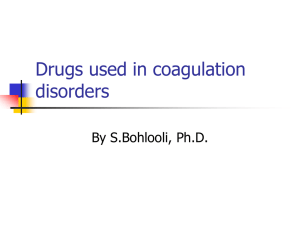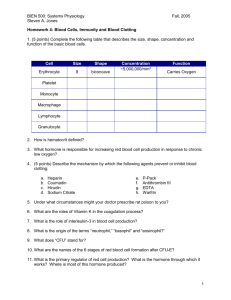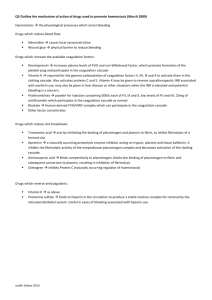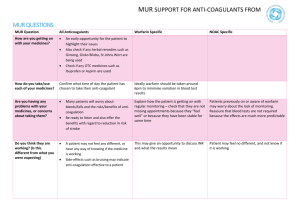Side effects → Contraindications
advertisement
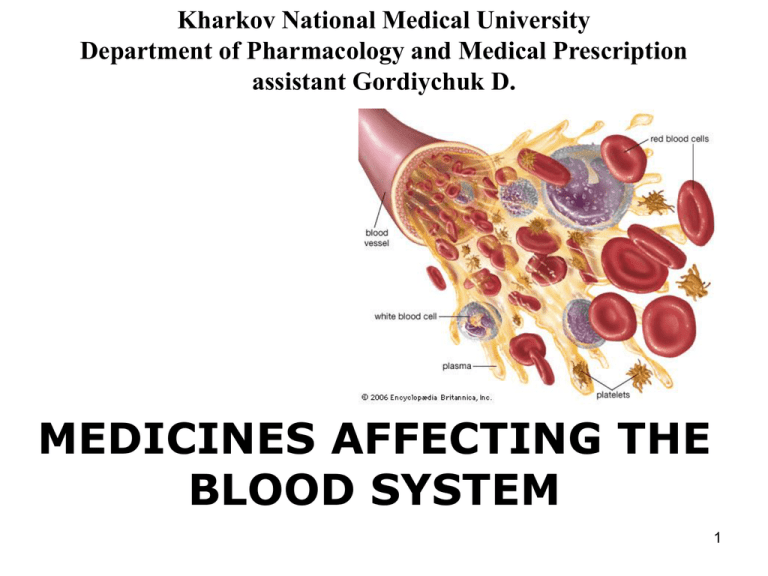
Kharkov National Medical University Department of Pharmacology and Medical Prescription assistant Gordiychuk D. MEDICINES AFFECTING THE BLOOD SYSTEM 1 THE SYSTEM OF BLOOD CONSISTS OF: •Peripheral blood (circulating in vessels) •Bloodforming (Hemopoietic) organs: the red bone marrow, lymphatic nodes, and spleen •Bloodbreaking organs (liver, spleen) •Neurohumoral regulation system 2 BLOOD CONSTITUENTS 3 Drugs acting on haemopoiesis 4 Red Blood Cells Erythrocytes • Place of formation – the red bone marrow • Period of life ≈ 120 days • Functions: - Transport (respiratory, nutritional, excretory function) - Defense - Regulation of blood рН 5 DISORDERS OF ERYTHROPOIESIS ANEMIAS Anaemia is a decrease of erythrocytes and/or hemoglobin in blood Anemia can be considered to be a syndrome, not a diagnosis The main types of anaemias are as follows: ─ Iron deficiency, ─ B12-vitamin and folic acid deficiency, ─ Hypoplastic anaemia ─ Hemolytic anaemia 6 7 1. IRON DEFICIENCY ANEMIA Hypochromic anemia Rather wide-spread type of anemia Decreased amount of iron in the organism makes it not possible to synthesize nessisary amount of hemoglobin Iron deficiency is especially for women a common problem, 5% of women between the ages of 20 and 49 have iron deficiency with anemia and 11% have iron deficiency without anemia 8 9 SYMPTOMS OF ANEMIA 10 IRON ABSORBTION IN THE GASTROINTESTINAL TRACT • Only ionized iron can be absorbed Fe2+ is absorbed best of all • HCl facilitates absorption as it converts elemental iron into ionized form • Ascorbic acid facilitates absorption as it converts Fe3+ into Fe2+ • calcium, antacids, tetracycline and chloramphenicol inhibit Fe2+ absorption • Fe2+ binds to apoferritin and in the form of ferritin (with Fe3+) crosses intestinal epithelium 11 IRON METABOLISM: Step 2 in blood only Fe2+ is included in hemoglobin but Fe3+ is transported by transferrin ! 12 PHARMACOLOGICAL CORRECTION OF THE HYPOCHROMIC ANEMIA IRON SUPPLEMENTATION What iron compounds should be used as drugs for parenteral administration: Fe2+ or Fe3+ ? For parenteral – only Fe3+ ! and for peroral – Fe2+ and Fe3+ is possible 13 NB! Iron-containing drugs for peroral administration should never be administered at one time with iron-containing drugs for parenteral administration ! Why ? Transferin is in a limited amount! When transferrin is saturated by iron coming from the GIT poisoning by iron administered parentally is highly possible because it would be present in blood in free form that is toxic ! 14 Desferal is an antidote for iron Erythropoiesis stimulants (antianaemics) 1. IRON-CONTAINING MEDICINES FOR ENTERAL ADMINISTRATION Fe2+ compounds Ferrous sulphate Ferro-gradumet Ferrous glucanate Fe3+ compounds Ferrous saccharate Ferrous hydroxide polymaltose complex Ferrous protein-acetylaspartylate Combined drugs: Ferroplex Feramide Hemopheron Sorbifer durules FOR PARENTERAL ADMINISTRATION Fe3+ compounds Ferrous hydroxide polymaltose complex Ferrous saccharate Ferrum-lek (dextrane containing complex) 15 IRON-CONTAINING MEDICINES Iron-containing medicines are donors of an iron ion and stimulate the synthesis of haemoglobin Pharmacodynamics (effects) → Indications Increases amount of the erythrocytes Prevention and treatment Increases saturation of erythrocytes of iron by haemoglobin deficiency Improvement of the tissues in hypochromic oxygenation anaemias The reduction of symptoms of anemia (weakness, paleness, tachycardia etc.) which begins in 5-7 days after the start of treatment 16 IRON-CONTAINING MEDICINES SIDE EFFECTS Side effects → Contraindications Dyspepsia, pain in the epigastric area, intestinal colics, seldom ulceration of the GIT Constipation (resulting from binding of iron to H2S in the intestine and bowels) Teeth darkness (resulting from binding of iron to H2S in the oral cavity and forming of black compound FeS) Black colour of feces imitating intestinal bleeding Nausea, vomiting, hemosiderosis, hypotension – in parenteral administration Diseases of the GIT, anaemias that are not connected with the deficiency of iron in the organism 17 2. B12-DEFICIENCY AND FOLIC ACID DEFICIENCY ANAEMIAS • Hyperchromic anemias • Characterized by presence of megaloblasts in blood • Lack of vitamin B12 or folic acid leads to the disorder of erythropoisis due to the supression of DNA synthesis (megaloblasts – abnormally large cells are formed because of disorder of cell division and imbalance between nucleus and cytoplasm development) Note that blood cells are one of the most intensively renewed in the body so they are one of the first to suffer in DNA and protein synthesis suppression18 19 Possible symptoms of hyperchromic anemia: • Disorders of peripheral sensitivity or tingling • Glossitis • CNS disorders (loss of balance, personality changes) 20 B12 binds to intrinsic Castle factor in the stomach and is absorbed by endocytosis in the intestine and concentrates in the liver, storage supply in the liver is enough for several years 21 Folic acid is water-soluble and is absorbed in small intestine and concentrates in the liver, but storage supply in the liver is enough for several months only 22 CYANOCOBALAMINE (VITAMIN B12) PROPERTIES The mechanism of action promotes the synthesis of the DNA Intensifies the cells’ division and the formation of erythrocytes as well as other highly divisible cells • transforms megaloblastic hemopoiesis into normoblastic one, normalizes the amount of erythrocytes, leucocytes and thrombocytes in blood • takes part in the synthesis of myelin and acetylcholine, decreases neurological disturbances connected with megaloblastic anemia • takes part in the function of the epithelium and 23 decreases disturbances in tongue mucosa INDICATIONS FOR CYANOCOBALAMINE (VITAMIN B12) Hyperchromic megaloblast anemia Hypoplastic anemia Radiation sickness Neurological diseases Liver diseases Dystrophy in children Glossitis FOR FOLIC ACID (VITAMIN Bc) Hyperchromic megaloblast anemia Chronic gastro-enteritis In pregnancy for the prophylaxis of neurological pathology of the fetus and newborn Side effects: allergy, hypercoagulation, tachycardia, pain in the heart, worsen in angina pectoris Note that folic acid in hyperchromic anemias should be used only in combination with B12! 24 ERYTHROPOIETIN Erythropoietin is the glycopeptide hormone that stimulates erythropoiesis It is produced by kidneys as a response for hypoxia The higher level of the renal hypoxia is, the more erythropoietin is produced Nowadays with the help of the genetic engineering human erythropoietins α, β, ώ have been obtained They are mainly used to normalize erythropoiesis in patients with chronic kidney diseases 25 ERYTHROPOIETIN The mechanism of action Stimulation of proliferation and differentiation of cells of the red bone marrow because of activation of the specific erythropoietin’s receptors Pharmacodynamics (effects) Increase in erythrocytes and reticulocytes amount, increase in the level of hemoglobin Side effects Increase of BP → Indications Anaemias caused by the chronic renal insufficiency, HIV- infection, after usage of cytostatics, in preterm born infants, hypo- and aplastic anaemias → Contraindications Hypertension 26 ERYTHROPOIESIS INHIBITORS -Sodium phosphate solution labeled by phosphorus-32 -Imiphos The mechanism of action suppresses the erythropoietic part of the bone marrow Indication: Erythremia it is an increased amount of immatured, inferior erythrocytes in blood because of their increased production by the red bone marrow Side effect: Anemia Contraindications: Erythropenia, HIV-infection 27 WHITE BLOOD CELLS •Place of formation – the red bone marrow, thymus, lymph nodes •Period of life – from few days to 10 years •Function: defence - Phagocytosis - Immunity (cellular and humoral) - Synthesis of antibodies with antibacterial and antitoxic properties - Synthesis of enzymes that increase permeability of capillaries 28 FORMATION OF BLOOD CELLS Leukopoiesis is the process of leukocytes formation and maturation. Leukopenia is the decreased amount of leukocytes in blood. Lymphogranulomatosis is a malignant tumour of the lymphoid 29 tissue. DISORDERS OF LEUKOPOIESIS AND THEIR CORRECTION The deficient production of leukocytes and decrease of their amount in blood (leukopenia, agranulocytosis) leukopoiesis stimulants and colony-stimulating factors that accelerate the formation of leukocytes in the bone marrow are used an increased production of inferior leukocytes (leukosis, leukemia) leukopoiesis inhibitors are needed 30 Leukopoiesis stimulants –Nucleic acid derivatives Sodium nucleinate – Pyrimidine derivatives Methyluracilum Pentoxilum – Colony-stimulating factors (CSF) Lenograstim Molgrastim The mechanism of action They bind to specific receptors of myeloid cell-precursors of the neutrophilic group, which are necessary for the matured leukocytes formation. 31 It leads to increase of the matured leukocytes synthesis. Leukopoiesis stimulants Pharmacodynamics (effects) → Leukopoiesis stimulants: the increase of the matured leukocytes amount in blood Side effects Leukopoiesis stimulants: dyspepsia Indications Leukopenia including those caused by the therapy with antitumour medicines, radiation sickness, HIV-infection → Contraindications Diseases of the GIT 32 Leukopoiesis inhibitors that suppress the formation of leukocytes. Leukopoiesis inhibitors Methotrexate Mercaptopurine Prednisolone Pharmacodynamics (effects) → Leukopoiesis inhibitors: decrease of the leukocytes amount in blood Side effects Indications Leukemias, lymphogranulomatosis → Contraindications Leukopoiesis inhibitors: inhibition of hemopoiesis, dysfunction of liver and kidneys Leukopenia, anaemia, thrombocytopenia, diseases of liver and kidneys Teratogenecity and embryotoxicity Pregnancy, lactation 33 Drugs acting on haemostasis 34 THROMBOCYTES • Place of formation – the red bone marrow • Period of life – 8-12 days • Function: The blood clotting Physiological properties: Adhesion – ability to stick to the foreign and damaged surface Aggregation – ability to form a clump (cork) Agglutination – pasting of thrombocytes one with another 35 THE BLOOD CLOTTING damage of vessels 2 phase – formation of thrombocytes cork 1 phase of blood clotting – vasoconstriction 3 phase – thromb (clot) formation from fibrin (marked yellow) and blood cells 36 COAGULATION HEMOSTASIS 37 FIBRINOLYSIS It is the process of fibrin dissolution I – formation of blood activator of plasminogen– extrinsic and intrinsic pathways II –conversion of plasminogen to plasmin III – plasmin disunites fibrin to peptides and amino acids (splits fibrin) 38 PATHOLOGY OF HEMOSTASIS AND FIBRINOLYSIS I – A decrease in blood coagulation and/or increase in fibrinolysis RESULT IN BLEEDING II – An increase in blood coagulation and/or decrease in fibrinolysis RESULT IN THROMBOSIS, thromboembolism, syndrome of disseminated intravasal blood coagulation 39 Drugs acting on hemostasis • • • • • • • • I. Drugs promoting haemostasis 1. Procoagulants 2. Fibrinolysis inhibitors 3. Heparin antagonist II. Drugs preventing clot formation 1. Anticoagulants 2. Antiplatelet drugs (Antiaggregants) III. Thrombolytics 40 ANTICOAGULANTS these are drugs decreasing blood coagulation 1. Direct acting - heparins (Heparin, LMW heparins: Enoxaparin, Fraxiparine, Dalteparin sodium) - factor Xa inhibitors (Rivaroxaban, Apixaban) - thrombin inhibitors (Lepirudin, Desirudin, Bivalirudin) 2. Indirect acting • coumarins • indandiones 41 Direct-acting anticoagulants Systemic-acting Local-acting HIGH MOLECULAR HEPARINS Heparin ointment Heparin LOW MOLECULAR HEPARINS Calcium adroparin Fraxiparine The mechanism of action Direct-acting anticoagulants have highly negative charge, which promote the formation of the complex with positively charged coagulation proteins. As a result, coagulation proteins are inhibited. 42 Pharmacodynamics (effects) → Indications Direct-acting anticoagulants Anticoagulant (inhibition phases) of blood coagulation at Myocardial infarction, direct blood all transfusion, surgery on the heart or vessels. Prophylaxis and treatment of embolism and vascular thrombosis Fibrinolysis activation, improvement Prophylaxis of thrombosis after coronary vessels shunting and of blood rheological properties prosthetics of the heart valves Thrombophlebitis, hypercoagulation aggregation of thrombocytes and erythrocytes, syndrome Antiaggregant (inhibition of adhesion and normalization of the blood rheological properties, improvement of microcirculation of the brain, myocardium, retina etc.) Hypolipidemic Prophylaxis and treatment of atherosclerosis (decrease of the lipid level in blood) Coronarodilating (improvement of blood Myocardial infarction, stable angina of tension circulation in the coronary vessels) Immunosuppressive Direct blood transfusion, surgery on the heart or vessels, rheumatism, bronchial asthma, glomerulonephritis, hemolytic 43 anemia, renal transplantation, endocarditis Heparin Mechanism of action • Heparin binds to the enzyme inhibitor antithrombin III (AT) causing a conformational change that results in its activation up to 1000-fold . • The activated AT then inactivates thrombin and other proteases involved in blood clotting, most notably factor Xa. 44 HEPARINE PHARMACOKINETICS Is administered intravenously (IV), intramuscularly (IM), subcutaneously (SC), topically begins to act immediately after IV administration and acts during 4-6 hours begins to act in 15-30 min after IM administration and acts during 6-8 hours begins to act in 30-60 after SC administration and acts during 8-12 hours Is metabolized in the liver by heparinase and is excreted with urine 45 SIDE EFFECTS OF HEPARINE Bleeding Hematomes Micro- and macrohematuria Thrombocytopenia Allergy Osteoporosis Hair silvering Protamine sulfate is an antidote for heparin 46 FRAXIPARINE low molecular weight heparin do not inhibit thrombin (acts through supression of Xa factor), so the control of activated partly thromboplastin time (laboratory analysis) is not needed Is administered subcutaneously once a day has higher bioavailability, longer duration of action, less binding to plasma proteins (in comparison with heparin) is used for the treatment of thromboflebitis, prevention of thrombus formation after surgeries 47 Factor Xa ihibitors • Rivaroxaban • Apixaban Mechanism: they act directly upon Factor X in the coagulation cascade, without using antithrombin as a mediator Advantages over LMW heparins and indirect acting anticoagulants: 1. Oral administration 2. Absence of hypoprothrombinemia 48 INDIRECT-ACTING ANTICOAGULANTS Warfarin Ethyl bisoumacetate Acenocumarol Fenindion Note that these drugs are vitamin K antagonists! The mechanism of action Indirect-acting anticoagulants have no influence on coagulation factors directly in the blood They supress the biosynthesis of coagulation proteins (proconvertin and prothrombin) in the liver as a result of antagonism with vitamin K. Pharmacological effects ─ a decrease in blood coagulation ─ an increase in fibrinolysis ─ a decrease in lipids concentration in blood 49 Oral Anticoagulants Vitamin K Antagonists (Coumarins) • Vitamin K is co-factor for the hepatic synthesis of clotting factors II, VII, IX & X warfarin By Vit.k reductase Vit. K (active form) Vit. K epoxide Warfarin inhibits Vit. K reductase no active form of Vit. K no synthesis of clotting factors Vitamin K Antagonists Warfarin Warfarin has 100% oral bioavailability, high plasma protein binding & long plasma t1/2 of 36 hours A high loading dose followed by an adjusted maintenance dose Warfarin is contraindicated with pregnancy as it crosses the placental barrier and is teratogenic in the first trimester & and induce intracranial hemorrhage in the baby during delivery Warfarin is metabolized by hepatic Cytochrome P450 enzymes with half-life of 40 hrs Warfarin Drug Pharmacokinetic & Pharmacodynamic Interactions Potentiating warfarin Inhibitors of hepatic P450 enzymes (cimetidine, cotrimoxazole, imipramine, amiodarone) Platelet aggregation inhibitors (NSAIDs e.g. aspirin) 3rd generation cephalosporins* Drugs displacing warfarin from binding sites (NSAIDs) Drugs reducing the availability of vitamin K Inhibiting Warfarin Vitamin K in some parenteral feed Inducers of hepatic P450 enzymes (rifampicin, barbiturates, … etc) Reduction of GIT absorption (cholestyramine) Diuretics Hypothyroidism Hepatic disease(↓ clotting factors)& hyperthyroidism (↑ basal metabolic rate) *Cephalosporins potentiate warfarin’s effect by killing vit.k producing normal flora INDICATIONS and SIDE EFFECTS FOR INDIRECT-ACTING ANTICOAGULANTS Prophylaxis and treatment of venous and arterial thrombosis, thromboembolism, thrombophlebitis, obliterating endarteritis, hypercoagulation syndrome, coronary insufficiency, miocardial infarction, ischemic insult, prevention of thrombosis after surgeries Nb! Side effects: Bleeding Forming of hematomes Hematuria Dyspepsia Supression of the liver function Allergy Index of prothrombin (laboratory value) should be controlled for the safety of the therapy! 53 FIBRINOLYTIC DRUGS (THROMBOLYTIC DRUGS) Direct-acting: Fibrinolysin Note that these Indirect-acting: Urokinase drugs are able to Streptokinase produce the lysis Alteplase of the blood clot! The mechanism of action Fibrinolytics (fibrinolysis activators) transform profibrinolysine (plasminogen) into its active form - fibrinolysine (plasmin), decrease the level of fibrinogen in the blood plasma, inhibit aggregation of thrombocytes and the activity of natural blood procoagulants, i.e. they activate the fibrinolytic system (fibrinolysis) Pharmacodynamics - Indications Fibrinolytic - dissolution of Venous and arterial thrombosis, fibrin filaments of the recent (up acute myocardial infarction, to 3 days) thrombs pulmonary embolism 54 FIBRINOLYSIN Is the protein from the donor’s plasma, the active factor of fibrinolysis Is administered by intravenous infusion has a direct action on fibrin and dissolves fibrin clot in the first hours after its formation Is used for the treatment of acute thrombosis, acute miocardial infarction, thrombophlebitis may cause bleeding resulting from an increase in fibrinolysis, allergy, anaphylaxis, arrhytmia, hypotension contraindicated in bleeding, a cerebral vascular accident, recent trauma of the brain, surgery, noncontrolled hypertension 55 STREPTOKINASE Is the proteolytic enzyme from hemolytic streptococcus has a plasma half life of 23 min, is administered by intravenous infusion (intracoronary infusion in myocardial infarction) acts indirectly, promotes the conversion of plasminogen to plasmin, causes systemic activation of fibrinolysis and degradation both of fibrin and fibrinogen resulting in dissolving of the thrombus is more potent than fibrinolysin does not cause arrhytmia 56 ALTEPLASE (ACTILISE) Is a tissue plasminogen activator, product of biotechnology has a half life of 5 min, is administered by intravenous infusion has a high affinity for fibrin act selectively on plasminogen bound with thrombus 57 DRUGS THAT DECREASE PLATELET AGGREGATION (ANTIAGGREGANTS) –COX-inhibitors Acetylsalicylic acid (aspirin) –Inhibitors of phosphodiesterase Dipyridamole –Inhibitors of ADP-mediated aggregation Ticlopidine (Ticlid) Clopidogrel 58 Acetylsalicilic acid blocks synthesis of thromboxane A2 by inhibiting COX1 Dipiridamol increases cAMP concentrations in the platelets that supresses clotting associated with TXA2 Clopidogrel and ticlopidine block ADP-receptors in the platelet membrane 59 ANTI-PLATELET EFFECT OF ASPIRINE Anti-platelet effect occurs in low doses 100-300 mg The effect lasts more than 48 hrs (till 7 days) Why? The inhibition of COX-1 is irreversible Platelets have no nucleus and they can not synthesize new COX-1 So the platelet that has once contacted with aspirin never would take part in blood clotting 60 And average period of platelet’s life is 7 days ANTI-PLATELET EFFECT OF DIPYRIDAMOLE Dipyridamole inhibits adenosine desaminase and phosphodiesterase in platelets, increases cAMP concentrations in the platelets and inhibits TXA2 synthesis that leads to decrease in platelet aggregation It also increases prostacycline level Remember antianginal drugs! Dipyridamole also increases myocardial oxygen supply by dilating coronary vessels but causes «stealing sydrome» - redistribution of coronary blood flow in favour of the normal areas of myocardium with61 the worsening of blood supply in the area of ischemia ANTI-PLATELET EFFECT OF TICLOPIDINE Ticlopidine irreversibly blocks purinergic receptors for ADP in platelet membranes The inhibition of ADP-induced expression of glycoprotein IIa/IIIa receptors in the platelet membranes decreases platelet aggregation 62 Antiaggregants • Dipyridamol • Ticlopidine • Acetylsalicylic acid Pharmacodynamics - Indications Antiaggregant effect Prophylaxis and treatment of the hypercoagulation syndrome, chronic coronary insufficiency. Prophylaxis of ischemic stroke and encephalopathies Side effects → Contraindications Bleedings, Low blood coagulability, increased thrombocytopenia permeability of vessels, peptic ulcer 63 THE PHARMACOLOGICAL “FACE” OF ANTICOAGULANTS AND ANTIAGGREGANTS Medicines Heparin Nadroparin* Acenocumarol Fenindion Dipyridamol** Ticlopidine** Acetylsalicylic acid • • Route of administration i/v i/m s/c s/c per os per os per os, i/v per os per os Onset of effect 5 min Duration of effect 2-6 h 15-30 min 30-40 min 3-4 h 2-8 h 4-12 h up to 6 h 24-48 h 10-24 h 2-4 days 24-72 h 1-2 days 20-30 min 8-10 days up to 7 days * - nadroparin is more safe than heparin; ** - dipyridamol`s activity is similar to aspirin, and ticlopidine is more active than aspirin. 64 MEDICINES INCREASING BLOOD COAGULATION (HEMOSTATICS, ANTIHEMORRHAGIC MEDICINES) Medicines that increase blood coagulation promote stopping bleedings they may be used locally as well as for resorptive action Classification of medicines Antifibrinolytic Hemostatics agents (inhibitors SystemicLocal-acting of fibrinolysis) acting Aminocapronic acid Tranexaemic acid Trasylol (Aprotinin) Fibrinogen Calcium chloride Menadion Thrombin Hemostatic sponge Coagulants of the synthetic, animal, plant origin Vicasol Gelatin medical Water pepper herb Nettle herb 65 MEDICINES INCREASING BLOOD COAGULATION (HEMOSTATICS, ANTIHEMORRHAGIC MEDICINES) The mechanism of action Antifibrinolytic agents inhibit the action of plasminogen and the action of plasmin; suppress the kinins’ system and the activity of fibrinolysis Hemostatics are the natural components of the blood coagulation system. Coagulants of the synthetic, animal and plant origin decrease permeability of the vascular wall, increase the blood viscosity, slow the blood flow, promote conditions for forming thrombi 66 Pharmacodynamics (effects) Hemostatic effect: stoppage or decrease of bleedings → Indications Inhibitors of fibrinolysis: bleedings caused by the increased fibrinolysis, thrombocytopenia, including ones caused by peptic and duodenal ulcer, postnatal bleedings Hemostatics: bleedings in surgery, obstetrics, traumatology caused by deficiency of blood coagulation system factors: capillary, from parenchymal organs, local bleedings (nasal, extraction of teeth, etc.) Coagulants of synthetic, animal and plant origin: hemorrhagic diathesis, metrorrhagia, nasal, renal, intestinal bleedings Side effects Increase of blood coagulation → Contraindications Predisposition to thrombosis, thromboembolism 67 THE PHARMACOLOGICAL “FACE” OF MEDICINES INCREASING THE BLOOD COAGULATION Medicines The route of administration Other effects / peculiarities Aminocapronic acid per os, i/v Anti-inflammatory, anti-allergic Fibrinogen i/v, locally Calcium chloride Thrombin Menadion per os, i/v It is a component of the blood coagulation system Hemostatic sponge Carbazochrome Nettle herb locally per os, i/m, i/v locally locally, s/c, i/v per os A synthetic water soluble vitamin K analogue A mixture of CaCl2 and thrombin on the solid carrier A synthetic solid Anti-inflammatory, capillary-stabilizing 68 PLASMA SUBSTITUTES Classification I. Salines: - Isotonic NaCl (0,9%) - Ringer-Loc sol. - Acesol - Trysol II. Alkaline solutions: - Sodium hydrocarbonate (NaHCO3) III. Drug contains the components of human blood: - human albumin - dry plasma 69 Classification IV. Synthetic plasma expanders: - Reopoliglukine - Neogemodes - Gekodes V. Glucose: - Isotonic Glucose sol. (5%) - Hypertonic Glucose sol. (10-40%) Indications for plasma expanders • Salines: compensation for loss of fluid in burns, diarrhea, vomiting; detoxification, drug dissolution - antibiotics, analgesics, cardiac glycosides; violations of water-salt state, correction of hemodynamic. Contraindications: threat of lung or brain edema, closed head injury with intracranial hypertension. • Alkaline solutions: metabolic acidosis. Indications for plasma expanders - Drug contains the components of human blood: hemodynamic instability in bleeding, burns, liver diseases, malnutrition in children; protein deficiency, dystrophy, as an agents for detoxification and substitutes in hemophilia B. Side effects: allergic reactions, caused by individual hypersensetivity. • Synthetic plasma expanders: blood loss, shock, burns, microcirculation disturbances, peritonitis, sepsis, diseases of the liver, intoxication in purulent and other diseases, prevention of thrombosis. Side effects: allergic reactions, lowering of blood pressure. • Glucose: (5% sol.) - replenishing the blood stream as plasma substitute, normalization of blood osmotic pressure. (10-40%) - dangerous swelling of tissues, brain, lungs; hypoglycemia, infectious processes, degeneration and atrophy of the liver, decompensated cardiac function, hemorrhagic diathesis, poisoning by narcotic analgesics, hydrogen cyanide, carbon monoxide, aniline, fosfogenom, shock and collapse. Thank you! 73
